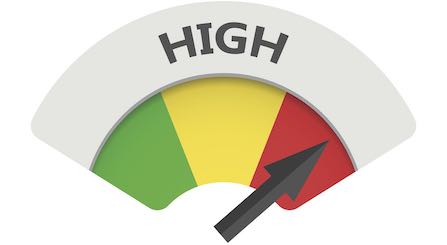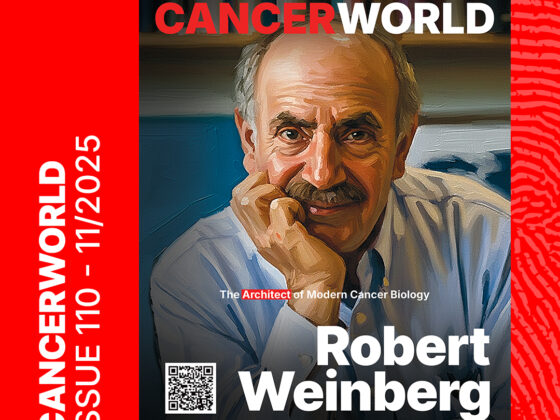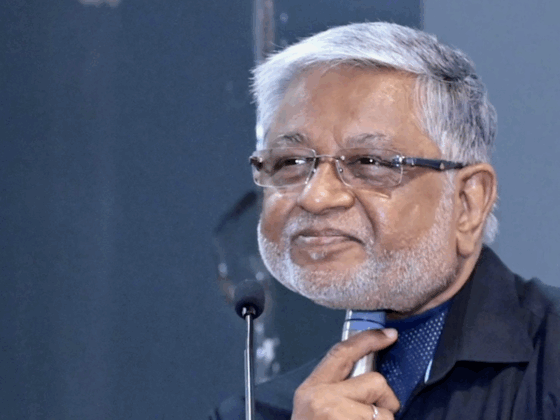In 2020, the San Antonio Breast Cancer Symposium (SABCS) co-organised in association with the American Association for Cancer Research (AACR) celebrated its 43rd year as the world’s premier annual breast oncology meeting. Like most conferences, due to the Covid-19 pandemic, for the first time this meeting was hosted as a virtual event. Despite these unique circumstances, this year’s conference was extremely rich: advances and practice-changing developments were presented.
We highlight here four presentations of particular relevance to patients.
Our highlighted trials
- A key trial showed that older women with early-stage breast cancer could forego adjuvant chemotherapy and radiation if they had a favourable recurrence score.
- A trial reported that addition of abemaciclib to standard adjuvant endocrine therapy improved invasive disease-free survival among women with high-risk, node-positive disease.
- Encouraging results revealed that non-invasive assessment of circulating tumour cells could accurately predict survival in patients with metastatic breast cancer.
- A phase III study demonstrated mindfulness and survivorship education reduce depression in younger women with breast cancer.
Older breast cancer patients can be safely spared chemotherapy and radiation
Two separate studies represent important steps towards ensuring that older patients with early stage breast cancer do not receive treatments unlikely to benefit them. Together the studies, one exploring omitting chemotherapy and the other omitting radiation therapy , suggest more-conservative treatment may represent a suitable option for some older women with breast cancer.
Although adjuvant postoperative systemic therapy and breast radiotherapy have become standard of care for breast cancer, there are concerns these treatments may be less well tolerated by older women. In developed countries over half of women diagnosed with breast cancer are aged over 65 years.
In the SWOG S1007 study (also known as RxPONDER), investigators screened 9,383 women with hormone receptor (HR)-positive, HER2-negative breast cancer and one to three positive lymph nodes to identify patients with Oncotype DX recurrence scores of 25 or less. The Oncotype DX technology assesses activity of 21 genes to generate scores indicating risk of recurrence ranging from 0 to 100. In total, 5,083 patients with scores <25 were identified (3,350 postmenopausal and 1,665 premenopausal). They were randomised to receive hormone therapy alone or hormone therapy plus standard chemotherapy. The study, run by the SWOG Cancer Research Network, was conducted in 632 sites across nine countries.
Results for the postmenopausal subgroup show 5-year invasive-disease-free survival (IDFS, a measure showing which women had localised breast cancer) was 91.6% for chemotherapy plus hormone therapy versus 91.9% for hormone therapy alone (HR=0.97, 95%CI: 0.78−1.22, P=0.82). By contrast, results for premenopausal women (n=1,665) revealed significant benefits for combination therapy: the 5-year IDFS was 94.2% for chemotherapy plus hormone therapy versus 89.0% for hormone therapy alone (HR=0.54; 95%CI: 0.38−0.76 P=0.0004).
“These results are practice-changing and demonstrate that postmenopausal women can be spared unnecessary chemotherapy and receive only hormone therapy,” said Kelvin Kalinsky, lead author, from Emory University, Atlanta. “This should bring more clarity to physicians and some relief for patients.” Commenting on the findings, Kent Osborne (Baylor College of Medicine) postulated that chemotherapy benefits observed in premenopausal women may derive from ovarian suppression, starving the tumour of oestrogen.
The PRIME 2 study, explored benefits of post-operative radiation therapy in patients aged at least 65 years. The study randomly assigned 1,326 patients with non-metastatic HR-positive breast cancer who had undergone breast-conserving surgery and were receiving adjuvant hormone therapy to receive either whole-breast irradiation (n=658; 40−50 Gray in 15−25 fractions) or no radiation therapy (n=668). Patients were enrolled from six countries.
The 10-year follow-up results show postoperative radiation therapy significantly affected risk of local recurrence: 9.8% for patients not receiving radiation therapy versus 0.9% for patients receiving radiation therapy (HR=0.12, 95%CI 0.05−0.32, P<0.0001). Notably, the investigators found post-operative radiation therapy did not significantly impact other outcomes. Distant metastasis was 1.4% for those receiving radiation therapy versus 3.6% for those not receiving it (P=0.07); recurrence in the opposite breast was 1.0% versus 2.2% (P=0.20); and overall survival was 80.4% versus 81.0% (P=0.68).
“Based on these results, we believe that omission of radiation therapy after breast-conserving surgery should be an option for older patients with localized, HR-positive breast cancer who are receiving adjuvant hormone therapy and meet certain clinicopathologic criteria,” said Ian Kunkler, the study presenter from the University of Edinburgh.
High-risk breast cancer patients benefit from abemaciclib
Addition of abemaciclib to standard adjuvant endocrine therapy improves invasive-disease-free survival (IDFS) for early stage high-risk, node-positive, HR-positive, HER2-negative breast cancer. The latest findings of the MonarchE trial, reported with a median follow-up of 19 months, have the potential to change adjuvant standard of care for high-risk breast cancer patients.
The MonarchE trial aimed to address unmet needs for the one in five patients with HR-positive early stage breast cancer who experience disease recurrence while taking endocrine therapy. Abemaciclib, a cyclin-dependent kinase inhibitor, is currently approved by the FDA for the treatment of patients with HR-positive/HER2-negative advanced or metastatic breast cancer in combination with a nonsteroidal, fulvestrant, or as monotherapy. The latest findings follow from the interim analysis conducted at a median follow-up of 15.5 months, presented earlier in the year at the ESMO Virtual Congress 2020.
In the open-label phase III trial, patients with HR-positive/HER2-negative, node-positive, high-risk early stage breast cancer were enrolled into one of two cohorts. The first cohort was based on clinicopathological risk factors (including four or more positive axillary lymph nodes (ALN) or one to three ALNs with a histology grade ≥3 or a tumour size ≥5cm).The second cohort comprised patients with ≥20% Ki-67 expression (indicating fast growing and aggressive tumours). Following surgery and radiotherapy and/or chemotherapy, all patients were randomised 1:1 to receive standard endocrine therapy for 5 to 10 years either alone (n=2,829) or with abemaciclib (n=2,808, 150 mg twice daily for up to 2 years).
At time of the current analysis, 1,437 patients (25.5%) had completed the two-year treatment period and 3,281 patients (58.2%) were within the two-year treatment period. The latest results, at a median of 19 months, found two-year IDFS rates were 92.3% for combination therapy versus 89.3% for endocrine therapy alone (HR=0.713, 95%CI 0.583−0.871, P=0.009). When investigators evaluated outcomes for 2,498 patients with ≥20% Ki-67 expression, two-year IDFS rate was 91.6% for the combination arm versus 87.1% for the endocrine therapy alone arm (HR=0.691; 95% CI 0.519−0.920, P=0.0009).
“These results may mark a notable treatment advance in the last two decades for people living with high-risk, node-positive, HR-positive, HER2-negative early breast cancer,” said study presenter Priya Rastogi, from the University of Pittsburgh School of Medicine. In a press conference, Kent Osborne (Baylor College of Medicine) commented that caution was needed since the follow-up was short, and the important question remained of whether disease-free survival curves would converge after two years when the abemaciclib was stopped.
Circulating tumour cells predict survival in metastatic breast cancer
Circulating tumour cell (CTC) levels can be used to predict the trajectory of metastatic breast cancer. A meta-analysis , showed that measuring CTC levels at baseline and one month following treatment can predict overall survival.
While conventional imaging is used routinely to monitor treatment response in metastatic breast cancer, the drawback is that it takes around three to four months for changes to be detectable on scans. In this study, Wolfgang Janni and colleagues (Ulm University Hospital, Germany), explored the potential of using CTCs, shed into the blood from tumours, for predicting overall survival. The team had access to data from 14 different data sets involving a total of 4,079 patients with metastatic breast cancer who had CTC status assessed with the CellSearch test at baseline and 29 days after starting treatment.
Results showed that, of the 2,961 patients found to be CTC-positive at baseline, 1,855 remained CTC-positive after starting treatment (positive/positive; 45.5% of the whole study population), while 1,106 had converted to being CTC-negative (positive/negative; 27.1% of the study population). For the 1,118 patients who were CTC-negative at baseline; 813 remained CTC-negative (negative/negative; 19.9%), while 305 had become CTC-positive (negative/positive; 7.4%).
Median overall survival was greatest for patients in the negative/negative group (47 months), followed by positive/negative (32.2 months), negative/positive (29.67 months), and positive/positive (17.87 months). The HR for overall survival for negative/negative patients versus positive/positive patients was 3.15 (95%CI 2.78−3.57; P<0.0001); while the HR for overall survival for positive/negative patients versus negative/negative patients was 0.49 (95%CI 0.44−0.54; P<0.0001).
“These results provide clinical validation of CTC monitoring as an early treatment response marker in advanced breast cancer and suggest the potential for clinical utility,” Janni told a press briefing.
Behavioural interventions reduce depression in young breast cancer survivors
Two behavioural intervention programmes have been shown to reduce depressive symptoms in younger women with breast cancer. The interventions, Mindfulness Awareness Practices (MAPs) and Survivorship Education (SE) can be delivered widely over virtual platforms reports the study.
Younger breast cancer survivors are known to be at increased risk for the negative effects of cancer diagnoses and treatment, including higher levels of depression and related symptoms, such as anxiety, stress, fatigue and sleep disturbance, which all diminish their quality of life.
For the phase III multi-centre study, Patty Ganz, from UCLA Jonsson Comprehensive Cancer Center (Los Angeles, California ), and colleagues, recruited 247 women who were diagnosed at age 50 years or younger with early-stage breast cancer, had completed treatment between six months and five years earlier and had at least mild depressive symptoms. The women were randomised to Mindful Awareness Practices (MAPs, n=85), Survivorship Education (SE, n=81) or a control group who were placed on a waiting list and offered their chosen intervention at the end of the study (WL, n=81).
Both MAPs and SE involved two hours of group sessions each week, with the programmes lasting six weeks. The MAPs programme provided instructions in how to use mindfulness to work with difficult thoughts and emotions and manage pain; while the SE programme covered topics including quality of life and medical management after breast cancer, relationships, work‒life balance, sexual health and physical activity. The primary outcome was depressive symptoms, measured according to the Center for Epidemiologic Studies Depression (CESD) scale, where lower scores indicate milder symptoms.
Results showed that women who followed either the MAPs or the SE programme achieved significant reductions in depressive symptoms compared to the control group. Baseline CESD scores were higher for women in the MAPs and SE groups (18.4 and 17.4 respectively) than for women in the control group (16.5). At three months the CESD score for women in the MAPs programme was 13.4 versus 17.3 in control group (P<0.001), and at six months the CESD scores were 12.9 versus 14.6 (P=0.013). In the SE group, at three months the CESD score was 13.6 in versus 17.3 in the control group (P=0.003), and at six months it was 12.7 versus 14.6 (P=0.063). Additionally, compared to women in the control group, patients in the MAPs group experienced significantly less sleep disturbance, hot flashes, and severe fatigue throughout the six months follow-up (P<0.05). There was minimal evidence to show SE had any impact on sleep disturbances, hot flashes, or severe fatigue.
“We’re excited to have two new (intervention) options to offer these survivors, and particularly the mindfulness program, which is available online and can be accessed by women across the country,” said Julienne Bower, an author of the study from Dana Farber Cancer Institute.












